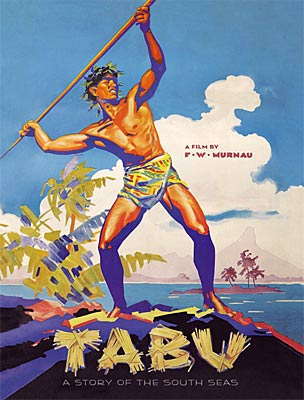 Van mijn grootvader heb ik enkele jaargangen van Universum geërfd, waaronder de zevende jaargang uit 1931 (nrs. 313 t/m 361). Dit weekblad van Dalmeijers Volksuniversiteit voor beschaving, wetenschap, efficiency, organisatie en succes besteedt ook aandacht aan volkenkunde. Het blad is strak en nuchter vormgegeven in de stijl van de crisistijd ofwel de Nieuwe Zakelijkheid. Ik moest aan de etnografische bijdragen in Universum denken toen ik de film Tabu: A Story of the South Seas uit 1931 van F.W. Murnau zag. Deze legendarische filmpionier kwam bij een verkeersongeluk in Californiëom het leven, deze maand precies tachtig jaar geleden. Tabu zou zijn laatste film zijn. De film werd gedraaid op Bora Bora en Robert Flaherty, die vijf jaar eerder Moana had gemaakt, assisteerde F.W. Murnau tijdens de opnamen. Tabu speelt zich net als Moana af in de Stille Zuidzee en hoort thuis in de categorie docufiction, een genre dat in het Nederlands meestal foutief vertaald wordt in docudrama. Arte zond maandagnacht de gerestaureerde versie uit waarin niet gesproken wordt.
Van mijn grootvader heb ik enkele jaargangen van Universum geërfd, waaronder de zevende jaargang uit 1931 (nrs. 313 t/m 361). Dit weekblad van Dalmeijers Volksuniversiteit voor beschaving, wetenschap, efficiency, organisatie en succes besteedt ook aandacht aan volkenkunde. Het blad is strak en nuchter vormgegeven in de stijl van de crisistijd ofwel de Nieuwe Zakelijkheid. Ik moest aan de etnografische bijdragen in Universum denken toen ik de film Tabu: A Story of the South Seas uit 1931 van F.W. Murnau zag. Deze legendarische filmpionier kwam bij een verkeersongeluk in Californiëom het leven, deze maand precies tachtig jaar geleden. Tabu zou zijn laatste film zijn. De film werd gedraaid op Bora Bora en Robert Flaherty, die vijf jaar eerder Moana had gemaakt, assisteerde F.W. Murnau tijdens de opnamen. Tabu speelt zich net als Moana af in de Stille Zuidzee en hoort thuis in de categorie docufiction, een genre dat in het Nederlands meestal foutief vertaald wordt in docudrama. Arte zond maandagnacht de gerestaureerde versie uit waarin niet gesproken wordt.

zo zwart-wit is de film
The original idea was for the film to be jointly made by Robert Flaherty and Murnau. Flaherty, the great ethnographic documentarian, had already met critical success with another Polynesian project, Moana (1926). Although Flaherty was a romantic in his own fashion, the two personalities did not mesh, and Flaherty somewhat bitterly sailed for home. Murnau, after the relative imprisonment of Weimar Berlin and mad Hollywood, loved Tahiti, Bora Bora, and the smaller islands. The informality and laxity of strictures on behavior (including sexual ones) seemed a kind of rebirth.
Bron: moma.org













